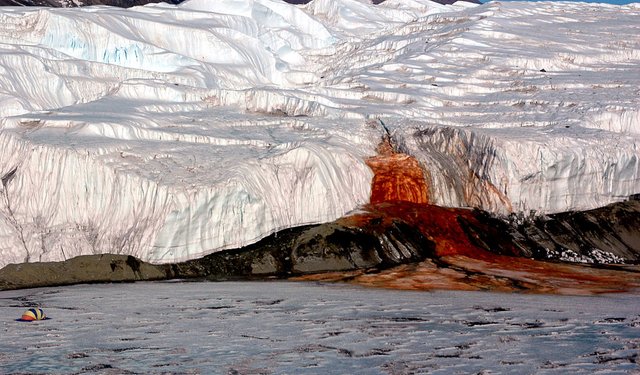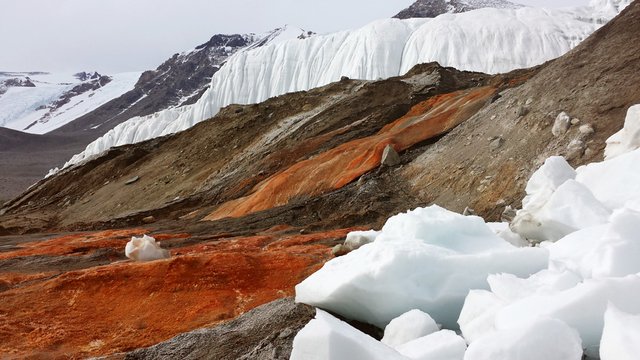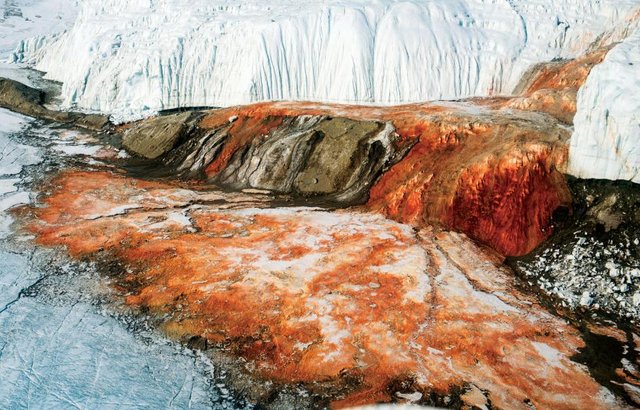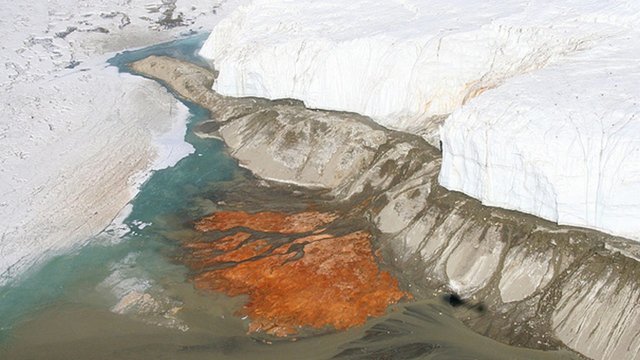Bizarre Natural Phenomena Vol.9 - Earth's Bleeding Wound (Antarctica's Blood Falls)
Welcome back, my nature lovers!! Flights have been cancelled due to frost, so we haven't left Antarctica yet (in case you missed it, my last post was on Antarctic ice fumaroles). Since we got plenty of time to spend here, let's take another walk around to see the sights.
Moving to Victoria Land, East Antarctica, we head to the Taylor Valley (of the McMurdo Dry Valleys). Don't be fooled by the name valley, ice and snow is still our dominant view. Now, imagine that everything, as far as you can see, is white. Walking around the ice fields suddenly something catches your eye! Something that's not supposed to be there, something that makes your blood cold (and it's not the freezing temperatures).

(Image source: wikimedia.org)
No! We're not witnessing a massacre scene! No one's been attacked by wild animals! The scarlet-red liquid you're seeing is just the Earth bleeding... RUST!
Bleeding rust?
Exactly! What you saw in the above photo is the Blood Falls of Antarctica. A stream of rich-in-iron brine, spilling out of an underwater lake. This lake has been secretly maintained under the Taylor Glacier, formed almost 2 million years ago. The glacier is almost 62 miles (100 km) long and runs through the Transantarctic Mountains.

(Image source: hiddenplacesonearth.com)
How did it all begin?
Well, the story goes long back in time, as long as 5 million years ago. East Antarctica was flooded by sea water that formed a salty lake over its surface. Years started to go by, decades, centuries and 3 million years later the Taylor Glacier began to form, trapping the lake's water under a sheet of ice. As the glacier became thicker and thicker, the lake froze being forced downwards getting saltier and saltier, but never froze completely.
The main mystery was, how does the water circulate within the glacier's body, where temperatures fall far below zero? We all remember from school that salty water freezes in temperatures lower than drink water, that explains the fact that the lake didn't get to freeze entirely. Add to that another paradox, as water freezes, latent heat escapes in the surrounding environment. Combined with the high salt-saturation, the lake was kept safe under tons of ice and able to form highly-pressured water-flows within the glacier's body.
As water escaped through the cracks in the ice, it started to freeze, but latent heat melted the surrounding ice, freeing the way for more water to get out, finally reaching the northern tip of the Taylor Glacier. Well-hidden and forgotten for so many years in a cavity with no light and oxygen, the brine got gradually enriched in iron (Fe) from the bedrock. The moment it escapes the big body of ice, the iron reacts with the oxygen (O2) in the atmposphere coloring the salty water...red! So, practically, the waterfall spews rust!

(Image source: nationalgeographic.com)
How do we know?
When scientists first discovered the Blood Falls in 1911, they presumed that its color derived from algea. Only recently did they discover that iron presence colors the water red. A study team from the University of Alaska Fairbanks used a technique very common in glacier investigating, called radio-echo sounding (RES).
This technique is pretty much similar to the echolocation bats use (for detecting their environment). Thanks to the salt presence, geologists managed to use the contrast with the fresh glacier ice to map a whole network of fissures under the glacier. They also managed to locate the brine's route to the surface through a 985-foot (300-meter) long path.
The "time-capsule experiment"
Sealed and burried under tons of ice, with no air and light supply, the lake became a wonderful natural experiment. Life managed to rise in darkness by creating a "recycling mechanism" to support existence in the lake's body.
Here's how it works.
The autotrophic bacteria that were detected in the lake's water, managed to survive by using sulphates (a sulfur compound) and ferric ions (positively charged molecules of iron) for respiration. That's right, they "breathe" sulfur and iron! The leftovers of this chemical reaction are sulphides (sulfuric anions - negatively charged molecules of sulfur). The sulphides react with the iron in the water to restore the levels of sulphates so that the bacteria will have enough "food" in the future.

(Image source: hiddenplacesonearth.com)
A wonderful discovery for scientists
This mechanism has surprised scientists, as they have never seen anything like this before. These microbes get to sustain life under extremely harsh conditions. Studying them could give us an idea of how life formed and developed in its early stages, long before oxygen became abundant in the atmosphere.
For those bold enough to imagine it, it could indicate the possibility of life existence on other planets. However, given the fact that the exact same conditions cannot coincide on another planet, this theory would be hard to believe in. Still, to our human eyes it remains a remarkable sign of life's strong-willed persistence and success!
The guy from SciShow gives a wonderful presentation of the phenomenon. Watch him!
References
nationalgeographic.com
sciencealert.com
atlasobscura.com
forbes.com
wikipedia.org

My fellow Steemians, thank you for reading today's post! I hope you found it interesting enough to follow me, @ruth-girl, for more fascinating phenomena!
If you have a thing for strange phenomena, you can check the previous articles of this series:
1 - Volcanic Lightning
2 - Bioluminescence
3 - Flammable Methane Ice
4 - Door To Hell
5 - Blue Lava
6 - Everlasting Lightning Storm
7 - The Mummifying Lake
8 - Ice Fumaroles
Interested in science? Please, don't forget to check the @steemstem project, a community-driven project meant to promote well-written, high-quality, STEM-related content (STEM as for Science, Technology, Engineering and Mathematics). Join them in steemit.chat for more information.
And for those engaging with education, @steemiteducation is here to join all steemian educators in their common cause of making our job easier, more effective and more fun!
Until my next post, Steem on, people, and keep smiling!

That was a very interesting read. Thank you for bringing it to our attention.
Antarctica holds many mysteries, some of which are coming to light now.
Thank you very much! I'm happy to hear you liked my article! There's a whole new world in Antarctica and I'll definitely mention it again in some of my articles.
Thank you very much!
This post recieved a vote from @minnowpond. For more information click https://steemit.com/steemit/@minnowpond/boost-your-rewards-with-minnowpond
Nature is absolutely amazing. Thank you.
I'm happy you liked it! :)
magic!!
Indeed!
Good topic and well structured :)
Thank you! :D
Hi, upvoted and resteemed by the Minnows Accelerator Project.
Any minnow quality content creator can signup.
Thanks a lot @accelerator!!
Wow! This time I definitely learned something from your post! This looks amazing (this reinforces my feeling that I need to go to Antartica at some point :p)
If you can handle the cold, you should definitely go there! It is an amazing place! :)
With appropriate clothes, I can handle any temperature ;)
Resteemed and 100% upvoted. Thank you for using my service!
Read here how the new bot from Berlin works.
@resteem.bot
Looks interesting. I'm going to read this;)
And you're followed.
Thank you so much!